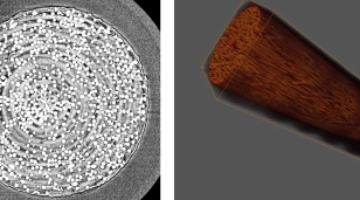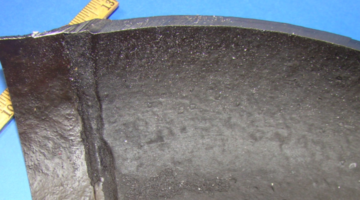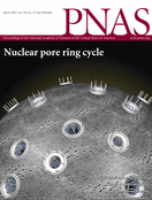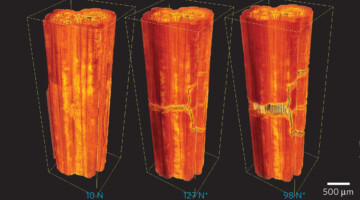Using ALS tomography capabilities, the EPA is currently investigating how biochar, a promising biofuel byproduct, sorbs environmental toxins and which kinds of biochar are the most effective. The possibilities for widespread use have already launched entrepreneurial commercial ventures.
Read more »![]()
TE Connectivity Finds Answers in Tomography
TE Connectivity designs and manufactures more than 500,000 different electronic connectivity products for the automotive, energy, industrial, broadband communications, consumer device, healthcare, aerospace, and defense industries. TE has been investigating how ALS tomography capabilities can help the company develop more efficient connectors.
Read more »![]()
![]()
ALS Gives Chevron Scientists New Insights into Corrosion Resistance
In the chemical environments common in energy production plants, steel pipes and equipment can accumulate layers of iron sulfide, some of which are corrosion resistant and provide protection to the steel surface. Understanding how operating conditions affect steel surface layers can improve corrosion rate estimates, decreasing building and maintenance costs, and increasing the safety and reliability of operating plants. Chevron Energy Technology Company (Chevron ETC) is currently studying the link between operating conditions and corrosion properties at ALS to determine which corrosion layers form and in what order.
Enabling Thin Silicon Solar Cell Technology
The effort to shift U.S. energy reliance from fossil fuels to renewable sources has spurred companies to reduce the cost and increase the reliability of their solar photovoltaics (SPVs). But thinner silicon is more susceptible to stress and cracking, leading one researcher from SunPower Corporation to mount a fundamental approach to systematically find stress and enable solutions for next-generation crystalline silicon SPV systems. Read more »
Ring Cycle for Dilating and Constricting the Nuclear Pore
Pictured is an illustration of several nuclear pore complexes (NPCs) embedded in a cell nucleus. NPCs act as gatekeepers between a cell’s cytoplasm and its nucleus. Based on crystallographic analyses, Sozanne R. Solmaz et al. uncover the molecular mechanism that underlies the large changes in diameter of NPCs and suggest a “ring cycle” mechanism for dilating and constricting the central NPC channel. The model could explain the ability of NPCs to accommodate transport substrates of a large size range and rapidly adjust to cellular transport needs. Read more »
Jamming Behavior of Domains in a Spiral Antiferromagnetic System
This schematic of x-ray scattering is from a spiral antiferromagnet with a spin structure that gives rise to domains with jamming behavior. Using resonant magnetic x-ray photon correlation spectroscopy, this research shows that the domains of a spiral antiferromagnet enter a jammed state at the onset of long-range order. Researchers found that slow thermal fluctuations of the domain walls exhibit a compressed exponential relaxation with an exponent of 1.5 found in a wide variety of solid-like jammed systems and can be qualitatively explained in terms of stress release in a stressed network. As the temperature decreases, the energy barrier for fluctuations becomes large enough to arrest further domain wall fluctuations, and the domains freeze into a spatial configuration within 10 K of the Néel temperature. The relaxation times can be fitted with the Vogel-Fulcher law as observed in polymers, glasses, and colloids, thereby indicating that the dynamics of domain walls in an ordered antiferromagnet exhibit some of the universal features associated with jamming behavior. Read more »
FDA Approves Drug for Type 2 Diabetes Invented with Aid of Protein Structure Data Taken at ALS
In January 2013, the U.S. Food and Drug Administration approved NESINA for the treatment of type 2 diabetes in adults as an adjunct to diet and exercise. NESINA was invented by scientists at Takeda California, who used ALS Beamlines 5.0.2 and 5.0.3 to collect x-ray diffraction data.
Space-Age Ceramics Get Their Toughest Test
Advanced ceramic composites can withstand the ultrahigh operating temperatures of jet engines, but detailed analysis of these materials at such high temperatures has been a challenge. In a new highlight with video, researchers describe a testing facility that enables microtomography of ceramic composites at temperatures above 1600°C.
Read more »![]()
![]()
August 29, 2013
Date-Change: Thursday, August 29 @ 12 noon in USB 15-253 Under Pressure: Why Diamonds Are a Crystallographer’s Best Friend!Christine Beavers, Experimental Systems Group, Beamline 11.3.1 Single Colony Home with Great Potential and Easy Access to Nearby Carbon Sources: Soil from a Microbe’s PerspectiveEoin Brodie, Earth Sciences Division, BSISB BeamlineRead More Read more »
Solar Cells: Spin-Cast Bulk Heterojunction Solar Cells: A Dynamical Investigation
Spin-coating is extensively used in the lab-based manufacturing of organic solar cells, including most of the record-setting cells. Aram Amassian and co-workers report in this study the first direct observation of photoactive layer formation as it occurs during spin-coating. The study provides new insight into mechanisms and kinetics of bulk heterojunction formation, which may be crucial for successful transfer to printing processes and scaling up production. Read more »
- « Previous Page
- 1
- …
- 8
- 9
- 10
- 11
- 12
- …
- 17
- Next Page »








